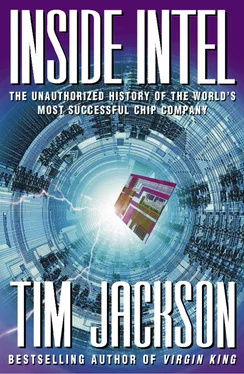The result of this transformation was that Intel rose to domination of its industry. Its memory chips, the products that generated most of its sales, swept the mainframe computer industry by storm, and its microprocessors became the standard on which the entirely new industry of the personal computer was built. It wasn’t the intrinsic merits of Intel’s products that brought about this domination. Instead, it was more apparently banal things like distribution, customer support, product range, documentation, and technical development tools.
The process was by no means smooth. Nearly nine years after Intel created the microprocessor, the company found itself running last in a three-way race for market share. Yet the company refused to give up. In a matter of days it created a campaign to convince its employees that regaining leadership of the microprocessor industry, and crushing its leading competitor, was a matter of survival. The campaign, called Operation Crush, worked like a dream. Intel’s microprocessor, acknowledged even by its own engineers as technically inferior to the competition, had become the industry standard. Almost by accident, a later version of it was chosen by IBM as the basis for the IBM Personal Computer.
As the PC began to change the face of the computer industry in the 1980s, Intel once again went through a transformation. Now that it was the industry leader, the company no longer needed to focus on delivering ground-breaking new products or using marketing campaigns to overthrow a more powerful rival. Instead, the key to its continued success was to keep challengers at bay and to attack any threat to its high profit margins. So Intel planned and carried out a ruthlessly brilliant programme to change the rules of the chip industry. Instead of authorizing other companies to base their products on its designs – a practice, known as ‘second sourcing’, that was accepted as the only way to give customers security of supply – Intel resolved secretly that it would become the monopoly supplier of its chip designs. To achieve this goal the company had to flout a long-term technology agreement with a key partner. But the stakes were too high for this to be an obstacle.
So lucrative was Intel’s monopoly, though, that the company began to face the problem that plagues all successful technology companies: how to stop others from setting up new companies that threatened its position. Here Intel responded in a style that would have earned the respect of any general on the battlefield. It launched a string of long-running lawsuits – civil and criminal, state and federal – against competing chip design teams, former employees, semiconductor manufacturing plants, venture capitalists and at one stage nearly even going to war with the computer companies that were its own customers. Intel’s legal department spent hundreds of millions of dollars, and the general counsel who headed it was at one point told that one of the targets he would have to meet in order to get a good performance appraisal was a fixed number of new lawsuits to start each quarter. The strategy of suing everyone in sight wasn’t likely to win many friends, and Intel lost or settled more cases than it won. But the policy of filing writs first and asking questions later helped Intel to hold on to its monopoly profits for longer.
The other focus of this ‘exclusion’ phase of Intel’s history was branding. After years of giving its products only part numbers instead of names, the company realized at the end of the 1980s that the ultimate way to keep competitors out was to make consumers associate the Intel name with high quality and reliability. So the company ran a succession of programmes encouraging PC buyers to concentrate on the processor inside, not the name on the box. First came the ‘Red X’ campaign, in which a big red X was spray-painted over the name of an outdated Intel chip that the company wanted to supersede. Then came ‘Intel Inside’, in which the company subsidized the cost of PC manufacturers’ advertisements if they included the right slogan and logo in their copy. Finally, in a move that made it dramatically harder for competitors to attract the attention of customers, the company switched from numbering its processors to giving them names.
Brilliantly successful at excluding competitors though it was, this campaign had a side-effect. It infuriated many of the most powerful players in the PC industry. They saw Intel’s promotion of its brand as a direct threat to their own, and a move that would tilt the balance of power against them in favour of low-cost, no-name companies that would now have the credibility of Intel’s backing. In one startling moment, the CEO of Compaq Computer went public with a withering attack on Intel’s strategy.
Though the issue continues to rumble on, it has to some extent been overtaken by events. Intel’s domination of the microprocessor industry is now so complete that the company has little to gain from making life harder for rivals building processors that conform to the Intel instruction set, or chip makers promoting entirely different standards. In the late 1990s Intel is in the position of a gardener who has marked out a plot and removed all the weeds. Its job now is cultivation. In this fourth and latest phase of the company’s history, the objectives are to make sure that every time a consumer walks out of a store with a PC in a cardboard box, more of the total selling price of that machine falls straight to Intel’s bottom line; to persuade consumers to replace their PCs more often – or as a second best to keep their old machines, but upgrade the Intel processors inside them; and to make the PC as a whole a more attractive product, so that people choosing between buying a new TV and a new computer will make the choice that brings in profits for Intel.
This new ‘cultivation’ phase puts Intel in the position of being less a competitor to other companies than a leader for an entire industry. It has given the company an incentive to develop new technologies not because it hopes to make money from them directly, but because they can increase overall demand for computers. For instance, Intel developed a piece of software which allowed people to make telephone calls over the Internet – and gave it away, inviting people to download it for free from its web site. No matter that there were other companies trying to sell such software, or that Intel’s new package might threaten an existing line of conferencing products that the company had developed. The point was simply that the new software package gave customers without a PC a new reason to buy one.
With booming sales and profits, fewer threats on the horizon than for many years, and tens of thousands of employees whose loyalty is assured by the hundreds of thousands of dollars they stand to make from Intel stock options, the company seems almost unassailable. But it has its weaknesses – and they, like its strengths, are intimately tied to the personality of one man. To a greater degree than most outsiders realize, Intel is the personal creation of its chief executive, Andy Grove.
Andy Grove, a Hungarian refugee who anglicized his name after arriving in the United States by boat in 1956, is one of the most extraordinary figures in American business. He is brilliantly intelligent and articulate, driven, obsessive, neat and disciplined. Intel has been built in his image. The values taught in the company’s private ‘university’ – directness in confronting problems and extreme rationality in approaching management questions – are an extension of Grove’s own personality.
Andy Grove’s slogan – some have called it ‘Grove’s Law’ – is ‘only the paranoid survive’. Daily life inside Intel follows this maxim to the full. By comparison with Microsoft, the company is almost obsessively secretive. The house joke is that its photocopiers are fed with paper that is already marked ‘Intel Confidential’ at the top of every page. The company also operates a security department whose job is surveillance not only of competitors or thieves that might harm Intel’s interests, but also of the company’s own employees. This department has several times crossed the boundaries of what is considered proper behaviour in US corporate life.
Читать дальше








![Chade-Meng Tan - Search Inside Yourself - Increase Productivity, Creativity and Happiness [ePub edition]](/books/703803/chade-thumb.webp)
